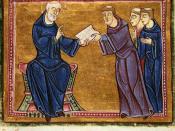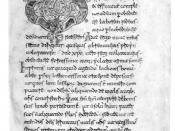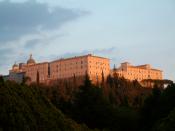The Holy Rule of St. Benedict and Cenobitic Monasticism
The Holy Rule of St. Benedict was originally written around 530 while St. Benedict himself was living at the monastery of Monte Cassino, a monastery that he had founded after leaving Rome because of the rampant immorality of its people (www.newadvent.org). The Rule itself begins with a Prologue that is directed to those "that by the toil of obedience ⦠mayest return to Him" (par. 2), referring to those who follow the precepts that God admonished through complete obedience. Further into the Prologue, St. Benedict exhorts that, "...having our loins girt with faith and the performance of good works, let us walk His ways under the guidance of the Gospel, that we may be found worthy of seeing Him who hath called us to His kingdom" (par. 6).
The main goal of writing his rule was to create a structured set of laws and principles for those who lived the monastic life.
His rule outlines the specific roles and expectations of an abbot and his monks, heavily basing the outlined principles on scripture. These principles were set forth in hopes that he "who hastenest to the heavenly home, with the help of Christ⦠with God's help attain at last to the greater heights of knowledge and virtueâ¦" (ch. 73). This meant that those who followed the rule and lived a cenobitic lifestyle would gain everlasting life with God.
The term cenobitic monasticism is defined as "a form of monasticism characterized by strict discipline, regular worship, and manual work" (www.dictionary.com). St. Benedict preferred cenobitic monasticism over the other forms of monasticism because Cenobites closely followed the teachings of God, under both a rule and an abbot, and lived selfless day-to-day lives, while the other forms were less structured and relied...


